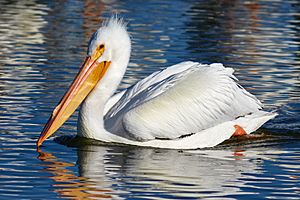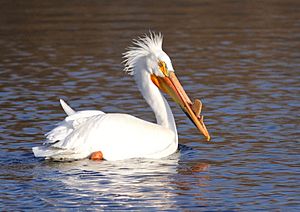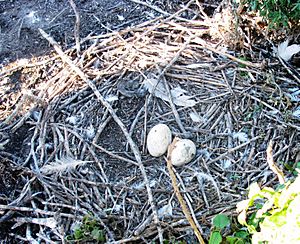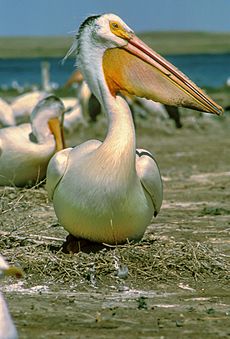American white pelican facts for kids
Quick facts for kids American white pelican |
|
|---|---|
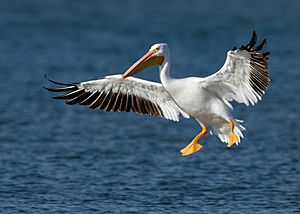 |
|
| Flying in Dallas, USA | |
| Conservation status | |
| Scientific classification | |
| Genus: |
Pelecanus
|
| Species: |
erythrorhynchos
|
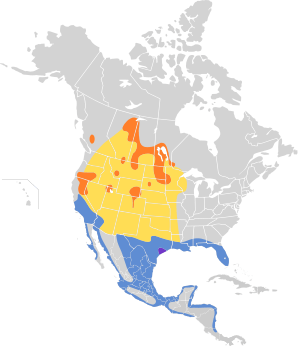 |
|
| Synonyms | |
|
Pelecanus erythrorhynchus (lapsus) |
|
The American white pelican (Pelecanus erythrorhynchos) is a very large water bird. It belongs to a group of birds called Pelecaniformes. These pelicans live in North America during the breeding season. In winter, they fly south to warmer places like Central America and South America, and also to the coasts.
Contents
About the American White Pelican's Name
The German scientist Johann Friedrich Gmelin first described the American white pelican in 1789. Its scientific name, Pelecanus erythrorhynchos, tells us something special about it. The word Pelecanus means "pelican" in Latin. The word erythrorhynchos comes from two Ancient Greek words: erythros, which means "red", and rhynchos, which means "bill" or "beak". So, the scientific name means "red-billed pelican".
What Does the American White Pelican Look Like?

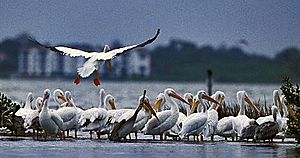
The American white pelican is one of the longest birds in North America. It can be about 127 to 178 centimeters (50 to 70 inches) long. This is partly because of its huge beak! Males have beaks that are about 28.7 to 38.6 centimeters (11.3 to 15.2 inches) long. Females have slightly shorter beaks, about 26.2 to 36.1 centimeters (10.3 to 14.2 inches) long.
These birds have a very wide wingspan, usually between 241 to 305 centimeters (95 to 120 inches). This huge wingspan helps them glide easily when they fly long distances. They can weigh anywhere from 3.5 to 13.6 kilograms (7.7 to 30 pounds). Most pelicans weigh between 5 to 9 kilograms (11 to 20 pounds).
Their feathers are mostly bright white. But if you look closely when they fly, you'll see black feathers on the tips of their wings. In spring, before breeding, their chest feathers turn a bit yellowish. After they shed their feathers, their head might look a bit gray.
The Pelican's Special Beak
The pelican's bill is very big and flat on top. It has a large pouch underneath. During the breeding season, the beak, the skin around the eye, and the feet turn a bright orange color. Their eyes also turn orange.
A unique feature of the American white pelican is a flat "horn" that grows on the top of its beak during the breeding season. It's the only pelican species with this horn! The horn falls off after the birds have mated and laid their eggs. When it's not breeding season, their beak, pouch, and feet become a duller orange-flesh color, and the skin on their face turns yellow.
Male and female pelicans look almost the same, except for their size. Young pelicans are light gray with brownish necks and wing tips. Their beaks and feet are dull gray. Baby pelicans are born without feathers, then grow soft white down feathers before getting their gray immature feathers.
Where Do American White Pelicans Live?
American white pelicans build their nests in large groups called colonies. These colonies can have hundreds of pairs of birds. They choose islands in remote salty or freshwater lakes in North America. Some of the most northern nesting spots are in Canada, while the most southern are in California and Wyoming.
In winter, they fly to warmer places. They can be found along the Pacific and Gulf of Mexico coasts, from California and Florida all the way south to Panama. They also live along the Mississippi River. When they are in their winter homes, they prefer calm waters like river mouths and lakes, rather than the open ocean. They can fly over deserts and mountains during migration. Sometimes, strong storms like hurricanes can blow them off course, and they might be seen in unexpected places like the Caribbean.
Wild American white pelicans can live for more than 16 years. In zoos, some have lived for over 34 years!
What Do American White Pelicans Eat?
Unlike their relatives, the brown pelicans, American white pelicans do not dive into the water to catch fish. Instead, they catch their food while swimming on the surface. Each pelican eats more than 1.8 kilograms (4 pounds) of food every day! They mostly eat fish like Common carp, Tui chub, shiners, Sacramento perch, Yellow perch, Rainbow trout, and catfish. They also eat other animals like crayfish and amphibians. If they live near salty lakes where food is hard to find, they will fly long distances to better feeding spots.
American white pelicans often hunt together in groups of a dozen or more birds. This way, they can work as a team to gather fish into one spot, making them easier to catch. If the water is too deep or fish can escape easily, they might hunt alone. Sometimes, these pelicans will even steal food from other birds, like other pelicans, gulls, or cormorants. This is called kleptoparasitism.
How Do American White Pelicans Reproduce?
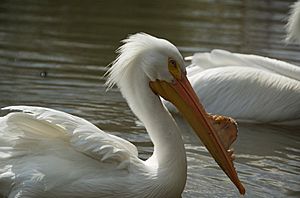
American white pelicans are colonial breeders, meaning they nest in large groups. A single nesting site can have up to 5,000 pairs! They arrive at their breeding grounds in March or April, and nesting begins between early April and early June. During this time, both male and female pelicans grow that special bump or "horn" on top of their beaks. This horn falls off after they have mated and laid their eggs.
Their nest is a shallow dip in the ground. They gather twigs, sticks, and reeds to line it. After about a week of courtship and nest building, the female lays her eggs. Usually, she lays 2 or 3 eggs, but sometimes only 1, or even up to 6.
Both parents take turns sitting on the eggs to keep them warm, which is called incubating. This lasts for about a month. The young pelicans leave the nest when they are 3 to 4 weeks old. At this point, usually only one chick from each nest has survived. For the next month, the young birds stay together in a group called a "creche" or "pod." They grow their immature feathers and learn to fly. After they learn to fly, which is called fledging, their parents continue to care for them for about three more weeks. Then, the family groups break up, and the birds gather in larger groups to prepare for their migration south. They usually start their journey in September or October.
Who Hunts American White Pelicans?
Pelicans often nest on isolated islands. This helps protect them from animals that might hunt them on land. However, Red foxes and coyotes can still hunt pelicans if they can reach the colonies. Coyotes are even known to hunt adult pelicans that are sitting on their nests. Several types of gulls (like herring, ring-billed, and California gull) and common ravens are known to eat pelican eggs and young chicks. Young pelicans can also be hunted by large birds of prey like great horned owls, red-tailed hawks, bald eagles, and golden eagles.
Pelicans react differently to different threats. If a human gets too close to their colony, they might temporarily leave their nests. But if another bird tries to attack, the pelicans will stay and fight them off by jabbing with their large beaks.
Status and Conservation of the American White Pelican
The American white pelican is a protected species under the Migratory Bird Treaty Act of 1918 in the United States. Globally, it is considered a species of Least Concern by the IUCN. This means that its population is stable and not currently at high risk of disappearing.
However, there are still challenges. Losing their natural homes is a big problem for nesting pelicans, especially due to floods and droughts. Human activities can also harm them, such as getting tangled in fishing gear, being disturbed by boats, and other ways their habitat is damaged.
In the middle of the 20th century, the number of American white pelicans dropped a lot. This was mainly because of harmful chemicals like DDT used in farming, and also because wetlands were being drained and polluted. But thanks to stronger environmental protection laws, their populations have recovered well. Today, their numbers are stable or even growing. By the 1980s, there were estimated to be over 100,000 adult American white pelicans in the wild. Even with this recovery, problems like erosion at nesting sites and occasional poisonings from chemicals near their homes can still occur.
Images for kids
See also
 In Spanish: Pelícano blanco americano para niños
In Spanish: Pelícano blanco americano para niños



